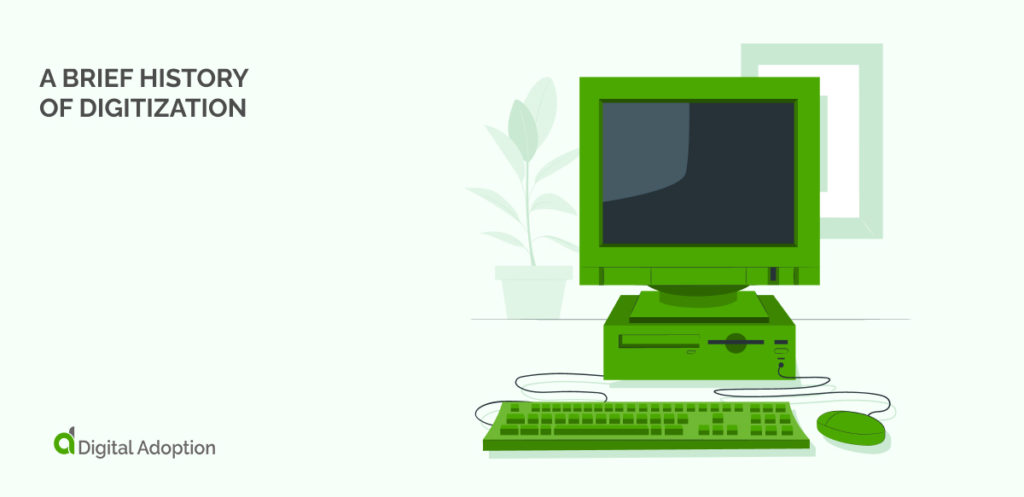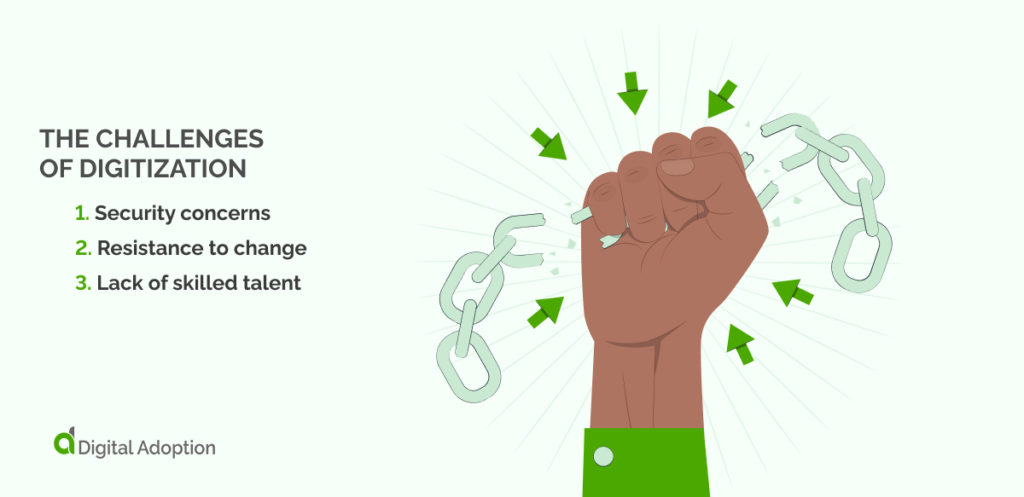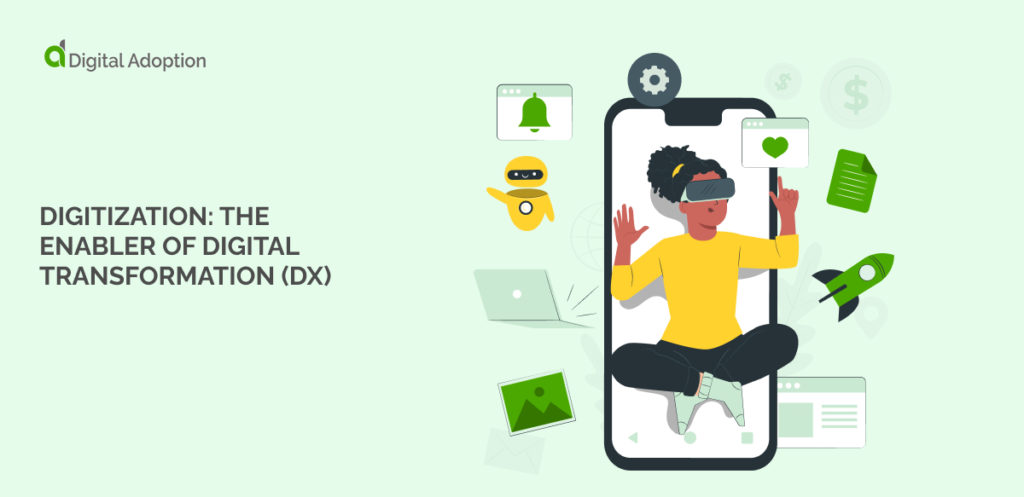Digitization is a term that has become commonplace in the past two to three years. It refers to the process of leveraging digital technologies and turning physical content into digital content.
While digitization started as a means for archiving, today, it has become a catalyst for true digital transformation (DX). Some companies have even given up their traditional data centers and moved their software and data online.
Understanding the four main areas of digital transformation, and utilizing the power of digitization within these areas, can help companies succeed in today’s fast-paced digital world.
According to Gartner, “Digitization is the process of changing from analog to digital form, also known as digital enablement. Said another way, digitization takes an analog process and changes it to a digital form without any different-in-kind changes to the process itself”.
There are several benefits to digitizing your business processes and moving away from traditional methods. Digitized content can be viewed easily on any device at any time, allowing workers to complete tasks more efficiently inside and outside the office. And since everything is stored digitally, it becomes easier to retrieve information when needed without sifting through piles of paper or other analog materials.
Overall, digitization has become an important component of digital transformation for many organizations today. Whether you are just starting out on your digital journey or are looking to further improve processes within your company, it’s clear that digitization plays a vital role in helping your business grow and succeed in today’s fast-paced environment.
How Is Information Digitized?
Digitizing information typically involves one or more of the following processes:
- Scanning. A scanner can be used to take a picture of text or another image and convert it into an image file, such as a bitmap.
- Optical Character Recognition (OCR). An OCR program scans a text image to distinguish between light and dark areas to identify each letter or number. Each character is then converted into an ASCII code.
- Recording. When you record something using audio or visual methods, such as magnetic tape or disks and then convert it to a digital format.
- Sampling. Sampling monitors an analog waveform’s signal strength at equal time intervals and translates these readings into numerical values for use as digital data.
A Brief History Of Digitization

In the late 20th century, digitization became more popular with the invention of personal computers and the internet. With these technologies, people could engage in digital preservation and convert types of information, like text, images, and audio and video recordings, into digital forms.
However, it wasn’t until the early 2000s that digitization became more widespread and a driving force in digital transformations for many organizations. This was largely due to cloud computing, data analytics, and mobile technology developments.
Nowadays, digitization is used across many industries to improve processes, increase efficiency, and enable real-time digital collections and analysis. The invention and continuing development of digital technologies have resulted in massive changes to the way we communicate and do business, impacting almost every part of our lives.
Digital adoption has led professional service firms to better growth and efficiency by allowing for more collaboration and communication with key stakeholders. Whereas traditional service firms relied on in-person meetings, phone calls, and paperwork to communicate with clients, digital adoption has allowed for better accessibility and timeliness.
With digital adoption, professional service firms can increase their growth and efficiency by streamlining processes, leveraging technology to automate tasks, and collaborating more effectively with clients. By embracing digital technologies in all aspects of the organization, they can stay competitive and stand out as a leader in their industry.
If you are looking to digitize a specific business process or are preparing extensive digital transformations, it’s important to understand the benefits and challenges of this digital enablement. With the right tools and strategies in place, you can begin to harness the power of digitization and unlock new opportunities for growth and success in today’s fast-paced business environment.
Digitization Vs. Digitalization Vs. Digital Adoption
There are some differences between digitization, digitalization, and digital adoption.
Digitization refers to a process where something is transformed into a numerical or symbolic representation. For example, digitizing a handwritten note would involve scanning it and then converting it into an electronic file that could be stored on a computer or mobile device.
Digitalization refers to the process of taking something that has been digitized and turning it into a digital asset, such as by storing it in a database for easy access and retrieval.
Digital adoption is the act of using new technologies or software to improve efficiency and productivity. This can include adopting automation systems like Industry 4.0 or incorporating big data analytics into existing processes to gain insights about customers, markets, or operations.
While all of these terms are related, each has distinct meanings and applications depending on the context. For companies looking to adopt Industry 4.0 practices and technologies, it is important to understand the differences between them to make informed decisions about how and when to use different digital tools and techniques for maximum benefit.
The Benefits Of Digitization For Modern Business Development
Digitizing your business processes has many benefits, such as increased efficiency, more accurate data collection and analysis, and improved customer engagement.
Another significant advantage of digitization is the ability to collect and analyze data in real-time, which enables businesses to make more informed decisions and take action quickly. This can lead to better resource allocation and a faster turnaround time on projects.
Key Benefits Include:
1. Greater flexibility and accessibility – Digitizing content allows businesses to view information on any device anytime, making it easier for workers to collaborate remotely or handle tasks when they are not in the office.
2. Faster turnaround time on projects – By automating repetitive tasks with business process automation, firms can reduce delays in the completion of projects and get their work done faster.
3. Better resource allocation – Real-time data collection and analysis allow companies to make more informed decisions about how they use their resources, including labor, equipment, and materials. This can lead to improved efficiency, increased productivity, and reduced costs overall.
The Challenges Of Digitization

Despite the many benefits of digitization, businesses must contend with several challenges.
Key Challenges Include:
- Security concerns – As more sensitive data is stored digitally, companies must be vigilant about implementing security measures to protect against digital materials from hacking and other online threats.
- Resistance to change – Transitioning from analog to digital systems can be difficult for many workers and managers. To encourage buy-in and maximize ROI, businesses must devise effective strategies for introducing new technologies and processes to the workforce.
- Lack of skilled talent – Companies need experts in technology, data analytics, and other emerging fields to digitize their business operations. However, this can be challenging in an age where digital skills are in high demand but in short supply.
Despite these challenges, the benefits of digitization far outweigh the costs, and businesses that embrace digital transformation will be well-positioned to thrive in today’s fast-paced world.
Despite these challenges, the benefits of digitization far outweigh the costs, and businesses that embrace digital transformation will be well-positioned to thrive in today’s fast-paced world.
Digitization Examples
One typical example of digitization is robotic process automation and automation in manufacturing. These technologies have enabled companies to streamline processes and improve productivity while reducing costs and minimizing errors.
Another example is eCommerce, which has disrupted traditional retail models by providing consumers with a convenient and easy way to shop online anytime and anywhere. This has led to a considerable increase in online shopping transactions and the development of new digital marketing strategies aimed at driving consumer engagement.
The use of big data analytics in healthcare has enabled providers to improve patient care by analyzing large datasets for insights into disease trends, treatment outcomes, and risk factors. This helps clinicians make more informed decisions about patient care and enables them to provide better preventive, diagnostic, and treatment services.
Some examples of information that can be digitized are as follows:
- Textual materials, such as books, articles, and contracts
- Visuals, such as photos, artwork, and medical visualizations
- Audio recordings, like music files, speeches, and interviews
- Video recordings, like movies, TV shows, and webcam footage
- Data, such as numerical readings from sensors, economic reports, and weather forecasts
Digitization Use Cases
One common use case for digitization is the automation of business processes. For example, a manufacturing company might use robotics and data analytics to identify bottlenecks in production and optimize workflow, resulting in reduced costs and improved efficiency.
eCommerce platforms such as Amazon, which have completely disrupted traditional retail models, are another example of how digitization can transform entire industries. These platforms offer consumers greater convenience, choice, and access to a wide range of products at the click of a button.
In healthcare, digitization has led to significant advances in areas such as genomics and personalized medicine. By collecting vast amounts of data on patients and analyzing it using big data analytics, providers can better understand disease etiologies and develop targeted treatments that are more effective and have fewer side effects.
In addition to making information more shareable and easier to access, there are other reasons a business might decide to digitize:
- To improve customer satisfaction
- To make processes more efficient.
- To increase revenue
- To expand your customer base by entering new markets
The key to successfully digitizing a business is having clear objectives from the outset. Once an organization understands its goals, it can select the right digital technologies and partners to help make the transformation happen.
Digitization vs. Digital Transformation
It’s crucial to understand that digitization is only one part of digital transformation.
Digital transformation refers to using digital technologies to establish novel or advanced business processes, products, and services. Digitization describes the process of changing information into a digital format. It’s a piece of digital transformation, but it doesn’t mean the same thing.
For example, a company might decide to digitize its customer relationship management (CRM) system as part of a larger digital transformation initiative. This would involve integrating the CRM with other parts of the business, such as marketing automation and accounting software, in order to create an end-to-end solution for managing customer data and interactions more effectively.
A company looking to digitally transform must take a strategic approach that considers the business’s goals and the specific needs of its customers and employees. This journey requires buy-in from leadership and a willingness to invest in new technologies and processes.
There are many challenges to overcome when digitizing an organization, including resistance from employees and stakeholders, changing organizational structures, and dealing with the risk of new technology failures.
However, businesses can successfully transition into this new digital era by adopting a data-driven mindset, focusing on customer needs and outcomes, and setting clear goals. Digital transformation requires a strategic approach that considers the unique needs and goals of your business, customers, and employees.
Business Transformation Enabled By Digitization

One of the biggest benefits of digitization is the potential for business transformation. By leveraging new digital technologies, organizations have more flexibility and agility than ever before, allowing them to adapt quickly to changing market conditions and customer needs.
Businesses can use data analytics to better understand their customers and offer personalized products and services that meet their unique needs. This approach has helped many companies build strong brand loyalty and achieve greater market share.
Another area where digitization is driving change is in the realm of supply chain management. Thanks to new technologies such as cloud computing, predictive analytics, blockchain, and Internet-of-Things (IoT), companies can now collect vast quantities of real-time data on production processes and consumer behavior.
This allows them to reduce waste and inefficiencies, optimize inventory management, shorten delivery times, and provide more accurate product forecasts.
Digitization & Industry 4.0
There is also a growing trend of digitization in the manufacturing sector, commonly known as Industry 4.0. This movement uses digital technologies such as robotics and industrial IoT to automate production processes, increase operational efficiency, and reduce costs.
With the rise of smart factories and connected supply chains, manufacturers can achieve unprecedented levels of visibility into their operations and make data-driven decisions that improve quality control and reduce risks.
Many experts believe that the digitization of industry will lead to entirely new business models and outstanding opportunities for small- and medium-sized enterprises. This shift has already begun. Some examples include low-volume metal parts created by building virtual 3D models, which are made possible through additive processes like direct metal laser sintering (DMLS).
With DMLS, a laser melts deposited metal powder layers to create parts similar to how 3D printing works. The metal in these parts is very dense and robust, making it suitable for mechanical purposes. Additionally, the DMLS process can create shapes that other machining processes cannot achieve.
While these are exciting times for digital businesses, it’s important not to get too caught up in technology trends. Success lies in a solid strategy aligning with your organization’s goals and objectives. By taking a holistic approach to digitization, you can unlock new opportunities for growth and transformation.
The Three-Step Workflow Digitization Process
Step 1: Review & Update Existing Processes
Guaranteeing that the entire enterprise is up to date and current with technology by reviewing all processes it consists of is digitization’s most crucial component.
Many businesses have workflows that are too complex to document thoroughly, leaving some processes unaccounted for. Either they rely on undocumented workers to fill in the gaps, or their documentation is inaccurate, leading to confusion and inefficient execution.
After documenting all processes that make up an organization’s workflow or workflows, the next priority is identifying a suitable process to begin digitization.
Step 2: Establish A Clear Digitization Process
Starting your enterprise’s digitization with processes already reliant on paper is a great way to start. Organizations using Managed Print Services can use the analytics provided by their service provider to assess their workflows and select processes with a high rate of hardcopy yield.
The Managed Print Service provides enterprise decision-makers with real-time print statistics on their fleet of printers, end users, and print jobs. These details are especially useful when making informed decisions about digitizing an enterprise’s workflow.
Companies should prioritize digitizing processes that are less complex and can be done quickly. This will ensure a successful transition to digital business models and avoid frustration. Businesses should save more complex processes for later on after they have gained experience digitizing other functions successfully.
Even the most uncomplicated process changes associated with digitization would necessitate foundational information and data before choosing and executing these minor modifications. Before digitizing any processes, it is crucial to speak with stakeholders to identify how it will affect customers and the expected enterprise cost and time savings.
The processes chosen to digitize should be highly impactful and able to garner support from upper-level management.
Step 3: Start Improving the Chosen Process
After you’ve gathered the process documentation in step one, your next task is to get key stakeholders involved in digital transformation right from the start by classifying process components.
First, enterprises should map out the chosen process to see where there are bottlenecks and areas for improvement. Finally, everyone involved should make a joint decision about digitizing the process.
Inter-related business processes that may cause conflict should be defined before going ahead with the digitization plan. This will help ensure that desired outcomes are achieved.
The Future Of Digitization

Looking ahead, we can expect the trend of digitization to continue expanding into new industries and markets. Many experts believe that the future of business lies in leveraging emerging technologies like artificial intelligence (AI), big data analytics, blockchain, and automation.
As these technologies become more sophisticated and accessible, organizations can gather more insights into their customers’ needs and behaviors. This will enable companies to deliver highly personalized products and services at scale.
In addition, digitization is expected to significantly impact how we work and collaborate with others. As machines start taking over many routine tasks, human workers will need to develop new skills such as creativity, critical thinking, communication, and collaboration to stay relevant in the digital age.
Key Drivers Of Future Digitization:
Asynchronous Manufacturing
Manufacturing lines that use traditional assembly methods are synchronous, meaning they follow predefined workflows based on production orders from enterprise business systems. Each manufacturing station receives instructions for the steps they need to take to keep the assembly line running smoothly.
Industry 4.0 runs on async manufacturing, where auto-identification technology tells each machine and operator what needs to be done to produce the customized end product at every step of production.
Industry 4.0 is defined as using new machines that can change and adapt to the needs of the specific part being made. This process creates a lean, efficient, and agile production line that can produce many different types of products in one facility.
The emergence of mass customization has allowed for the profitable production of small batches (including single unique items) by rapidly configuring machines to customer-supplied specifications and additive manufacturing.
Analytics
Industry 4.0 systems gather data that can be used with analytics to improve productivity and performance. For example, real-time predictive maintenance helps companies avoid unplanned downtime due to machine failures on the factory floor—thus improving asset utilization.
Analytics also enables companies to better understand and respond to customer needs by observing customers’ behavior in real-time. This allows organizations to provide personalized products, services, and experiences that meet individual customer preferences and expectations.
Automation
Automation is a key driver of Industry 4.0, with much emphasis on robotics and connected systems. The goal is to improve automation levels so that machines can adapt to production volume and workflow changes, thus eliminating human error and waste.
Automation also allows companies to shift from a reactive to a proactive mode of operation by continuously monitoring equipment and processes in real-time. This helps organizations stay ahead of faults, failures, downtimes, or supply chain disruptions—and take preventative action when necessary.
Technology
The increasing compatibility between physical and digital objects, or cyber-physical systems, makes the Industry 4.0 concept increasingly achievable. Technological advances in platforms, data models, communications, and embedded processors driven by the Internet of Things are dramatically changing how machines interact with one another and people to optimize performance at all levels of production – from individual parts and products to entire factories.
CPS consists of physical components that are regulated or watched by computer-based algorithms. A present example of the application of CPS is mechatronic drive systems that use processors and communications embedded in motor drives to achieve coordinated operations in a packaging machine without traditional gearing. This saves significant money while also being more flexible and reliable.
What’s Next For Digitization?
Digital representation of physical objects, interconnected devices, and autonomous systems are driving the next revolution in digital. As more companies adopt Industry 4.0 practices such as asynchronous manufacturing, analytics, automation, and technology, they will be able to stay competitive in the digital age by producing high-quality products and services efficiently and quickly.
Ultimately, this will allow them to better meet the needs of their customers and anticipate the changing demands of the market.













